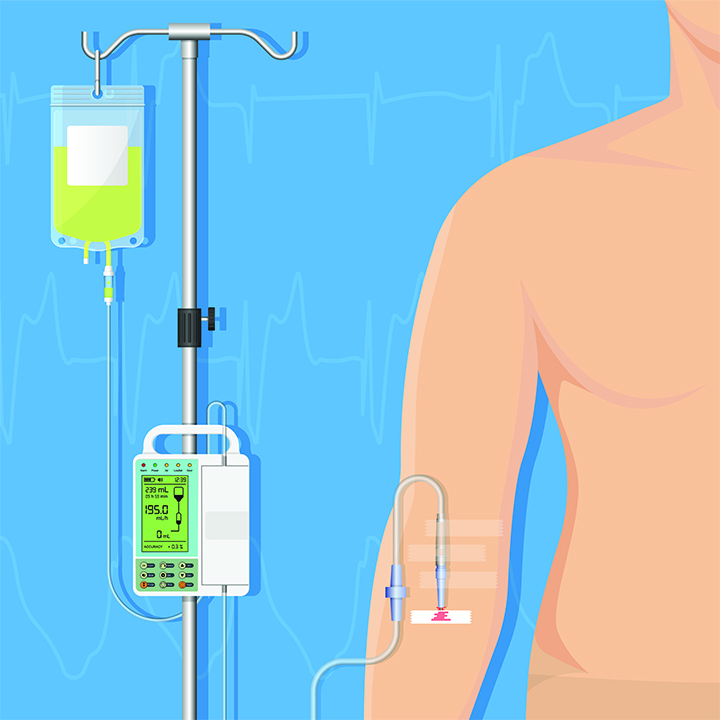When organizations and clinicians team up, patients are protected.
Takeaways:
- Medication administration errors continue to occur due to mistakes in smart electronic infusion pump setup, programming, and clinical management.
- Patients suffer the consequences of medication errors associated with smart infusion pumps, resulting in therapeutic regimen disruption, loss of therapeutic effect, debilitating injury, or even death.
- Healthcare organizations must design infrastructures—through smart infusion system procurement, implementation, application, maintenance, and continuous quality improvement—that support patient safety.
Visual Abstracts for Download (Facebook/Twitter):
(Click on arrow icon next to 100% to download.)
Twitter Digital Abstract 5.2021 Smart
Medication administration errors are among the most vexing and costly events in healthcare. For the patient, errors related to therapeutic infusions can present grave consequences, including therapy disruption, over- or underdosing that reduces the therapeutic effect, debilitating injury, or death. In 2020, the Institute for Safe Medication Practices (ISMP) published Guidelines for Optimizing Safe Implementation and Use of Smart Infusion Pumps. This resource, compiled and reviewed by clinical experts, outlines the components necessary for developing an organizational infrastructure that promotes safe patient care using smart infusion pump technology. In April 2021, The Joint Commission released a Sentinel Event Alert on smart infusion pumps that also contains useful strategies.
Smart infusion pumps are sophisticated computer systems that communicate within a network, using software and hardware designed to send the exact amount of medication at a precise rate to each patient. At the interface between the infusion pump and the nurse, critical decisions are made, presumptive actions are performed, and successful or deleterious outcomes are initiated.
Although smart infusion pumps have reduced I.V. infusion errors, continuing lapses (programming, pump setup, channel/line mix-ups) coupled with known smart pump technology limitations require ongoing efforts to protect patients from harm.
Smart infusion pump design
Among medical devices, smart infusion pump technology is unique. More than an electronic mechanical device (as their predecessors were), smart infusion pumps not only perform the mechanical task of “pumping” I.V. fluids and medications with greater accuracy and control, they also provide immediate, computerized, clinical support for medication administration at the point of care where it can intercept human error.
Smart infusion pumps have dose error-reduction systems (DERS) designed to enhance safe I.V. medication administration via a customizable drug library that places organization-specific parameters on volume, concentration, rate, and duration for most infusion therapies. The library is designed to accommodate each organization’s specific I.V. formulary and to meet patient population needs in multiple care areas.
Pharmacists and clinical experts in each organization adopt safety measures, such as standard concentrations; high and low limits for rate, dose, and volume (for example, mg/hr, mg/kg/hr); and standard medication nomenclature as the drug library is constructed. The parameters can prohibit the infusion; warn the clinician of an inaccurate dose or rate; or accept the programmed infusion based on the patient care area, selected medication, and qualifying prescriber’s order (infused rate, dose, and volume).
Some smart infusion pumps have components that allow medication label barcode scanning, which facilitates auto-selecting medications from the drug library. This feature removes the need for clinicians to search the drug library where look-alike medications or multiple concentration entries might lead to selection errors. The barcode scanning process was the precursor to smart infusion pump interoperability, which allows bi-directional (two-way) communication between the pump channel and the patient’s electronic health record (EHR). Bi-directional communication technology allows the pump to receive the medication order directly from the EHR and for the pump to send infusion data (medication, rate, dose, volume) to the patient’s EHR infusion record. (See Bi-directional benefits and challenges.)
Bi-directional benefits and challenges
Bi-directional smart infusion pumps raise the standard of care but also present some challenges.
Benefits
Bi-directional smart infusion pumps
- remove the human factor from manually programming the infusion pump
- connect the pump channel, medication order, and patient
- promote safe medication administration based on the provider’s order
- facilitate consistent and timely documentation of each infusion in the patient’s electronic health record.
Challenges
Bi-directional smart infusion pumps
- can be cost-prohibitive
- are available only with select infusion pump brands
- rely on a sound wireless infrastructure.
Organization responsibility
Healthcare organizations must design an infrastructure that supports patient safety through procurement, implementation, application, maintenance, and continuous quality improvement measures for smart infusion pump systems. This requires creating a supportive environment and ensuring that standardized, facility-approved resources are readily available at the point of care. (See Organizational responsibilities.)
Organizational responsibilities
Organizations must be fully engaged in developing infrastructure that leads and supports safe smart infusion pump use.
Choose appropriate smart infusion pumps
Use smart infusion pumps for therapies that require precise flow-control for safe administration.
- Pump selection
- Base selection on the prescribed infusion therapy, rate control requirements, infusion-related risks, patient care setting, and available organizational resources.
- Standardize the types of pumps used to promote user familiarity.
- Use separate, designated pumps for epidural infusions, enteral infusions, and irrigations to differentiate from vascular access infusions.
- Choose devices with anti-free-flow protection, air-in-line detection, and pressure and occlusion alarms.
- Base selection on the prescribed infusion therapy, rate control requirements, infusion-related risks, patient care setting, and available organizational resources.
- Bi-directional interoperability
- Consider implementing infusion systems that incorporate medication orders, a drug library, EHR, barcode medication administration, and reporting.
- Smart pumps with EHR interoperability reduce manual programming errors.
- Labeling
- Use medication labels on the infusion reservoir and health record documentation that are consistent in format and content with the smart infusion pump drug library.
Establish policies and procedures
The use, education, assessment, and maintenance of infusion equipment are established in organizational policies, procedures, and practice guidelines.
- Use
- Establish the use of smart infusion pumps with DERS for I.V. administration of medications and solutions (for example, continuous, intermittent, secondary infusions, PCA, and epidural, spinal, and nerve block infusions) throughout the acute care setting, including ambulatory settings (perioperative/procedural/radiology care areas, emergency departments, infusion centers).
- Set an organizational compliance goal for using DERS with all I.V. medications (ISMP recommends ≥ 95%).
- Education
- To ensure patient safety, clinicians must show competence in the use of smart pump equipment, including knowledge of indications, contraindications, and manufacturers’ instructions. The organization should provide:
- smart pump operation and management education to all clinicians during orientation and before using any device in the patient care setting
- ongoing training to address changes in drug library entries, usability issues, and avoiding workarounds and to assess routine users and new staff members.
- To ensure patient safety, clinicians must show competence in the use of smart pump equipment, including knowledge of indications, contraindications, and manufacturers’ instructions. The organization should provide:
- Assessment
- Establish policies to ensure CQI data are retrieved, analyzed, and used to improve patient safety.
- Institute regular bedside assessment checks to validate DERS use.
- Care and maintenance
- After each patient use, clean and disinfect infusion equipment (according to the manufacturer’s directions) with products that have antimicrobial activity against pathogens likely to contaminate the equipment.
- Inspect infusion equipment and supplies for integrity and function before, during, and after use. Look for damage before use; ensure packaging is clean, dry, and intact; and verify the expiration date.
- Remove defective pumps, associated supplies, and administration sets from patient use and label them as such. Report the problem to the appropriate department, the manufacturer, and the reporting organizations as required.
Design infusion pump drug library using DERS
- Initial drug library development
- Establish an interprofessional team to design and test the drug library.
- Ongoing drug library development
- To avoid unnecessary alerts, update drug libraries regularly (to address new drugs, new drug protocols, and drug shortages), and involve end users in the library design.
- Use a smart pump oversight team to assess CQI data and organizational I.V. medication error reports.
Organize a collaborative oversight committee
-
- Involve clinician end users in the evaluation of VAD and infusion products, equipment, and technologies, including clinical application, performance, infection and complication prevention, safety, efficacy, acceptability, reliability, and cost.
- Oversight committee
- Create a committee of pharmacists, nurses, prescribers, risk managers, medication safety personnel, biomedical engineers, information systems personnel, human factors engineers/experts, and others deemed essential to ongoing oversight for the smart infusion pump system.
- Members should meet routinely to:
- review CQI data from infusion pumps (good catches, overrides, percentage of basic functions [infusions programmed without using the drug library or safety software]), evaluate DERS use goals, and take steps to improve them
- review reported I.V. medication errors, including reporting medication and biologic agent adverse events and discrepancies to the appropriate department and authoritative reporting organizations; regularly review medication errors and identify and share lessons learned; determine if an error requires education, drug library revision, or pump hardware or wireless network repair
- review national error reports and determine if the organization is at risk for similar errors
- review usability issues that interfere with safe practice and clinician workflow
- review infusion-associated pump recall notifications and develop a plan to manage them
- standardize communication processes to inform end users of changes made to the drug library.
CQI = continuous quality improvement data, DERS = dose error reduction systems, EHR = electronic health record, ISMP = Institute for Safe Medication Practices, PCA = patient-controlled analgesia
Sources: Gorski et al., Institute for Safe Medication Practices
Clinician responsibility
According to the Infusion Nurses Society Infusion Therapy Standards of Practice, the nurse is responsible for ensuring patient safety through competent infusion equipment use, including knowledge of appropriate indications, contraindications, and manufacturer’s directions. When managing smart infusion pumps, clinicians must maintain clinical competency, adhere to organizational compliance goals, confidently manage the I.V. medication administration process, vigilantly prevent error, assess the patient and monitor the pump throughout each infusion, and ensure appropriate medication reconciliation and patient handoffs and transfers are performed. (See Clinician responsibilities.)
Clinician responsibilities
Clinicians must maintain their competency and adhere to organizational guidelines for managing smart infusion pump planning and administration.
Maintain clinical competency
- To ensure patient safety, stay current in infusion equipment use and maintain your knowledge of indications, contraindications, and manufacturers’ instructions.
Adhere to organizational guidelines
- Remain current in practice, and adhere to organizational policies, procedures, and guidelines.
Use patient safety technology
- Use the drug library in accordance with organizational policy, and avoid manual programming and overriding drug library alerts.
Select an appropriate infusion plan for each medication
- Identify medications that should be administered as uninterrupted primary infusions (for example, rapid infusion and critical medications).
- Plan and prepare for each type of required infusion (primary, secondary, intermittent, epidural, PCA), the associated supplies, and the required device type (large volume, syringe, epidural, PCA pump).
- Use an appropriate separate pump for each specific administration route (epidural, enteral, I.V.).
Manage known error-prone administration applications
- Secondary or piggybacked medications
- Know the capabilities of the smart pump for flow rate and volume control of secondary medications.
- When attaching a secondary set above the smart pump, use only a primary set that contains a back-check valve or use a dedicated set with integrated mechanisms to prevent retrograde flow of the secondary medication into the primary solution container.
- Follow the manufacturers’ instructions for correctly positioning the primary and secondary solution containers and the required height differences between the two containers (head-height differential). Incorrect head-height differential can lead to unintended flow rates.*
- Alterations in flow rate may occur due to differences in the solution level of each container (bag, glass bottle), I.V. pole height, and pump position.
- High-risk medications
- When high-risk medications are administered via the primary infusion system along with the primary infusion, attach the administration set below the smart infusion pump controlling the primary fluid flow and use a separate smart pump to control the rate of the high-risk medication.
Use appropriate accessories
- Use only accessory devices (administration sets, syringes, filters) that are designed to work with the smart infusion pump according to the manufacturer’s instructions for use.
- Use only administration sets with anti-free-flow mechanisms with smart infusion pumps.
Syringe pump safety
- If using syringe pumps to deliver small-volume infusions, use accessory devices that offer the smallest internal volume (microbore tubing, shorter length) to minimize residual volume.
- Follow the manufacturer’s instructions for maintaining consistent level and position of the syringe pump in relation to the patient while infusing.
- For infants, consider using multi-connector sets to accommodate multiple continuous infusions to increase accuracy and accommodate low flow rates.
Monitor patient during all infusions
- Routinely assess the vascular access site to detect infiltration or extravasation; smart pumps don’t detect these issues.
Maintain standard practice in patient care transitions
- Follow organizational policy for using flow-control devices during care transitions (for example, hospital admission of patient with an insulin pump).
PCA = patient-controlled analgesia
*Head height differential is the distance required between the secondary infusion container (which is hung higher to increase gravitational pressure) and the primary container (which is hung lower to decrease gravitational pressure). This differential enables the secondary medication to be administered to the patient first. When it’s completed, the primary infusion resumes flow to the patient at the pre-programmed rate.
Source: Gorski et al.
Standardized clinical workflows will help ensure routine performance of all safety measures and reduced risks to patient safety. (See Clinician workflows.)
Clinician workflow
Standardized procedural steps help clinicians initiate smart pump infusion therapy and maintain vigilance when monitoring and transitioning patients.
Patient identification
- Verify the patient’s identity using at least two identifiers, including the patient’s full name.
Medication verification
- Use barcode scanning technology when available to verify medications before administration.
- Compare medications and infusion solutions with the medication order and infusion pump.
- Review the medication label for the name (brand and generic), dosage and concentration, total volume, expiration date, administration route and rate, frequency, and any special instructions.
Rights of medication administration
Confirm the rights of safe medication administration (right patient, drug, dose, route, time, reason) and patient allergy status.
Infusion pump set up
- Follow the manufacturer’s instructions for positioning the infusion pump in relation to the patient.
- Prime the appropriate administration set, filters, or other add-on devices.
- Load the administration set into the pump correctly. For a secondary infusion, ensure the setup complies with the manufacturer’s instructions, and check the luer connections and roller clamp if applicable.
Infusion pump programming
- Scan the barcode on the patient’s identification band, medication label, and clinician identification.
- If barcode scanning isn’t available, manually select the medication from the drug library. If applicable, also select the secondary infusion.
- Verify the correct rate, dose, concentration, and volume to be infused, as well as the duration.
Infusion pump advisories
- If the smart infusion pump issues a clinical advisory alert after the infusion is programmed, review the warning message on the pump’s user interface (programming screen).*
- Review the programmed infusion parameters to ensure dose, rate, volume, and duration are correctly programmed according to the provider’s order.
- Resolve the clinical advisory alert according to the smart infusion pump directions for use.
High-alert medications
- Implement safeguards to reduce the risk of errors with high-alert medications.
- Perform independent checks by two clinicians for high-alert medications (for example, opioids, insulin, heparin, chemotherapy).
Infusion activation
- After all verifications and safety steps are complete, begin the infusion.
- Remain at the bedside to
- observe the drip chamber for active flow when applicable
- correct occlusions caused by inadvertently closed roller clamps or vascular access device
- observe the vascular access site and assess for patient discomfort.
Monitoring
- Monitor infusion pumps during administration to ensure safe and accurate delivery of the prescribed infusion rate and volume.
- Assess the patient and vascular access site throughout the infusion to detect complications or adverse effects.
Medication reconciliation
- Perform medication reconciliation at each care transition (admission, transfers to different levels of care, discharge to new healthcare setting) and when new medications are ordered. Verify discontinued medications to reduce the risk of medication errors, including omissions, duplications, dosing mistakes, and drug interactions.
Patient handoff
- At each transition to a new setting or service and as part of the handoff process, trace all catheters, administration sets, and add-on devices between the patient’s access device and the solution container before connecting or reconnecting any infusion or device.
Patient transfer
- Ensure the patient care profile (for example, adult critical care, adult general care, oncology, pediatric critical care) selected from the drug library is appropriate for the receiving unit when transferring patients from one level of care to another. The patient care profile appears on the pump’s programming screen and should be reviewed by each clinician during transfer and handoff.
- Each patient care profile contains specific medications, appropriate drug concentrations, and specific programming parameters with associated low and high limits for rate, dose, volume, and duration.
- If the patient care profile doesn’t match the patient’s level or area of care, patient safety is compromised. For example:
- Clinicians managing patients transferred from general care to critical care won’t have immediate access to some critical care medications and concentrations in the drug library.
- Patients transferred from critical care to general care might be subject to infusions of higher medication dose and concentration than intended for general care.
- If the patient care profile doesn’t match the patient’s level or area of care, patient safety is compromised. For example:
*Each organization designs its specific drug library for the smart pump, with experts in the facility determining how much drug (and how fast) the pump can administer. Soft-limit and hard-limit alerts occur if minimum and maximum dosages are exceeded. Soft-limit alerts can be overridden by the clinician to allow the provider and clinician some leeway to infuse a slightly larger or slightly smaller dose of medication when appropriate for the patient. When a soft-limit alert is issued, it’s as though the pump is asking the clinician, “Is this dose correct?” Soft-limit alerts are like rumble strips on the highway that alert the driver that they’re going outside the parameters of the lane. Hard limits are parameters built into the smart pump drug library that prohibit the infusion from taking place as programmed. Hard limits exceed soft limits on both ends. They’re like the masonry wall inside a road tunnel—you can’t drive over (exceed) into the other lane.
Source: Gorski et al.
Safety essentials
When using smart infusion pump technology, patient safety depends on the dedicated, collaborative efforts of the device manufacturer, healthcare organization, clinicians, and support professionals. Reducing I.V. medication errors requires embracing technology advancements, standardized care imperatives, clinician competency, continuous quality improvement initiatives, and sound organizational infrastructures. AN
Good catch
A patient is transferred to a critical care unit for uncontrolled hypertension, and the provider orders a nitroglycerin drip at 5 mcg/kg/min, which is verified by the pharmacy. The patient’s clinician, who’s new to practice, consults with two colleagues at the bedside to verify smart pump programming. When the infusion is programmed as ordered, the smart pump issues a hard-limit alert and won’t permit the infusion to begin. The clinician contacts the pharmacy to re-verify the ordered dose parameters. They’re verified as correct.
The clinicians at the bedside check whether the pump is in the critical care profile portion of the library that allows access to medications and concentrations necessary in critical care units. The pump is in the profile.
The clinician contacts the ordering provider again to re-verify the nitroglycerin order. The provider immediately recognizes the problem. The order should have been 5 mcg/min, not 5 mcg/kg/min. The order is corrected, the pump is programmed at the correct rate, and the patient receives a safe starting rate for the nitroglycerin infusion.
The medication administration process includes four separate steps before medication reaches a patient: ordering, transcribing and verifying the order, dispensing and delivering the medication, and administering the medication. Errors can occur at any point in the process. Safety checks should be placed at each step to catch an error before it reaches the patient. In this case, the error moved undetected from one step to the next and wasn’t identified until the smart infusion pump intercepted it, protecting the patient from a significant overdose of nitroglycerin.
Access a “good catch” story at myamericannurse.com/?p=74383.
The authors work at the Infusion Nurses Society in Norwood, Massachusetts. Dawn Berndt is the clinical education and publications manager and Marlene Steinheiser is the director of clinical education.
References
Blandford A, Dykes PC, Franklin BD, et al. Intravenous infusion administration: A comparative study of practices and errors between the United States and England and their implications for patient safety. Drug Saf. 2019;42(10):1157-65. doi:10.1007/s40264-019-00841-2
Giuliano KK. Intravenous smart pumps: Usability issues, intravenous medication administration error, and patient safety. Crit Care Nurs Clin North Am. 2018;30(2):215-24. doi:10.1016/j.cnc.2018.02.004
Gorski LA, Hadaway L, Hagle ME, et al. Infusion therapy standards of practice, 8th edition. J Infus Nurs. 2021;44(suppl 1):S1-224. doi:10.1097/NAN.0000000000000396
Institute for Safe Medication Practices. Guidelines for Optimizing Safe Implementation and Use of Smart Infusion Pumps. February 10, 2020. ismp.org/guidelines/safe-implementation-and-use-smart-pumps
Kane-Gill SL, Dasta JF, Buckley MS, et al. Clinical practice guideline: Safe medication use in the ICU. Crit Care Med. 2017;45(9):e877-915. doi:10.1097/ccm.0000000000002533
Lapkin S, Levett-Jones T, Chenoweth L, Johnson M. The effectiveness of interventions designed to reduce medication administration error: A synthesis of findings from systematic reviews. J Nurs Manag. 2016;24(7):845-58. doi:10.1111/jonm.12390
Schnock KO, Dykes PC, Albert J, et al. A multi-hospital before-after observational study using a point-prevalence approach with an infusion safety intervention bundle to reduce intravenous medication administration errors. Drug Saf. 2018;41(6):591-602. doi:10.1007/s40264-018-0637-3
The Joint Commission. Sentinel Event Alert 63: Optimizing smart infusion pump safety with DERS. April 14, 2021.
U.S. Food and Drug Administration. Infusion pump risk reduction strategies for facility administrators and managers. February 2, 2018. fda.gov/medical-devices/infusion-pumps/infusion-pump-risk-reduction-strategies-facility-administrators-and-managers
U.S. Food and Drug Administration. Syringe pump problems with fluid flow continuity at low infusion rates can result in serious clinical consequences: FDA safety communication. August 25, 2016. fdanews.com/ext/resources/files/2016/08/08-25-16-pumpsafetynotice.pdf?1480880246
Wolf ZR, Hughes RG. Best practices to decrease infusion-associated medication errors. J Infus Nurs. 2019;42(4):183-92 doi:10.1097/NAN.0000000000000329patients are protected.


















